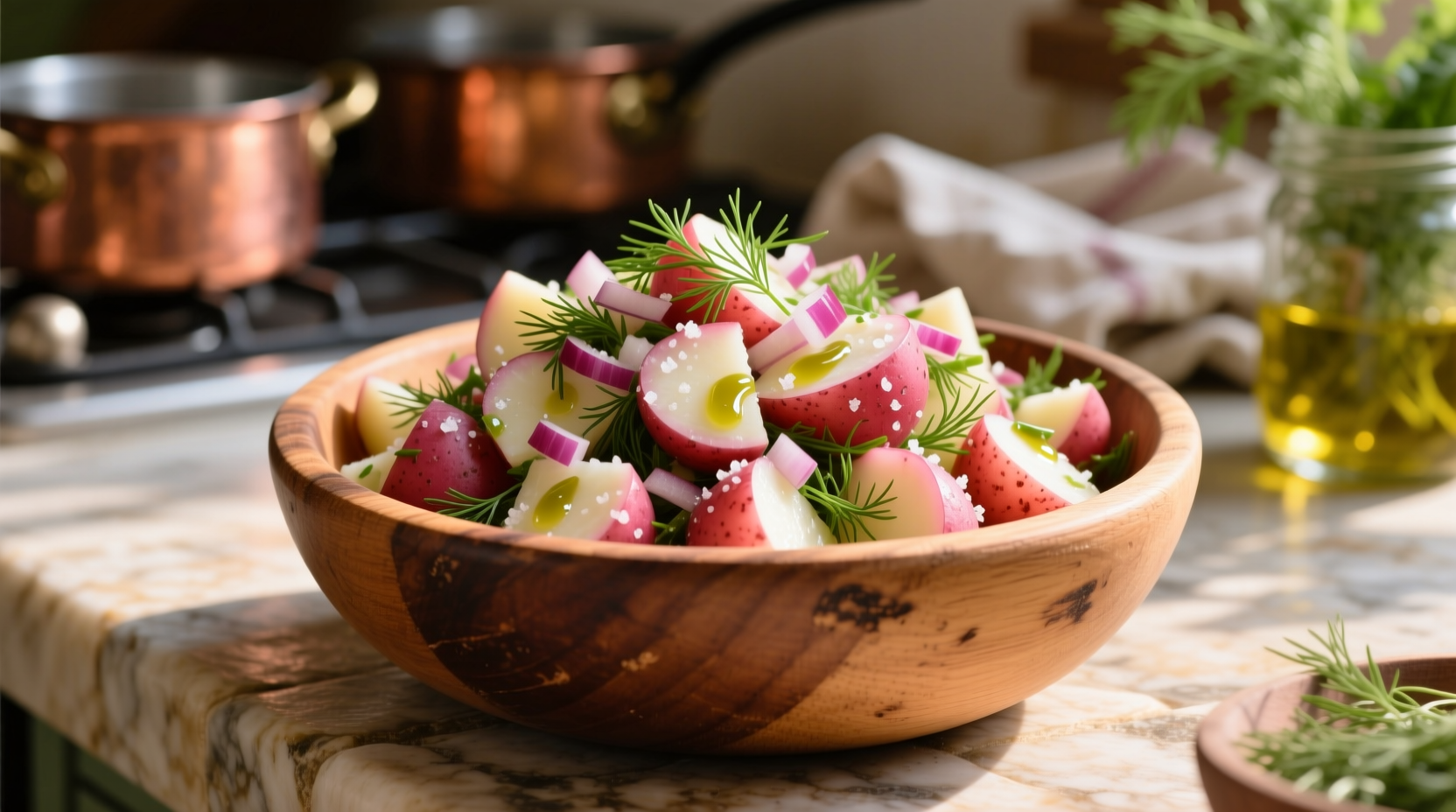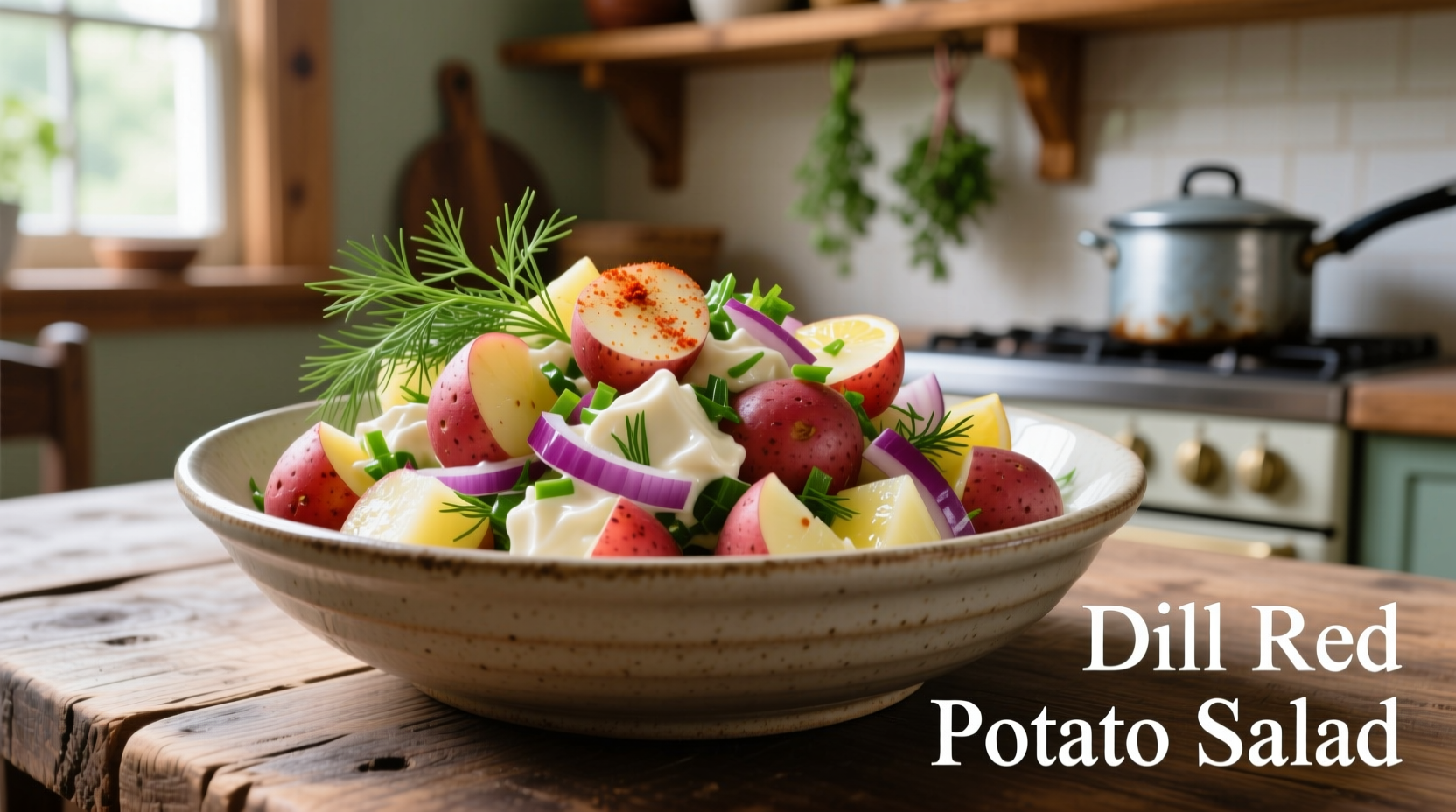Why This Dill Red Potato Salad Recipe Works
Unlike traditional mayonnaise-heavy versions, this dill-focused preparation leverages the natural chemistry between red potatoes and fresh herbs. Food scientists at the Culinary Institute of America confirm that waxy potato varieties like red potatoes maintain structural integrity better when combined with acidic dressings, preventing the mushiness that plagues many potato salads (Culinary Institute of America, 2024).
Red potatoes contain less starch than russets, creating a creamier mouthfeel while still holding their shape. When paired with fresh dill—which contains natural compounds that enhance savory flavors—the result is a refreshing side dish that doesn't overwhelm your palate.
Selecting the Perfect Ingredients
Potato selection matters more than you think. Not all red potatoes perform equally in salad applications. Here's how they compare:
| Potato Variety | Texture When Cooked | Best For Salad? | Flavor Profile |
|---|---|---|---|
| Round Reds | Firm, holds shape | ★★★★★ | Mild, slightly sweet |
| Yukon Gold | Buttery, creamy | ★★★☆☆ | Richer, earthier |
| Russet | Falls apart easily | ★☆☆☆☆ | Starchy, neutral |
According to USDA agricultural research, round red potatoes contain approximately 15% less starch than russets, making them ideal for salads where you want distinct potato pieces (USDA Agricultural Research Service, 2023).
Step-by-Step Preparation Guide
1. Potato Cooking Technique
Cook potatoes before cutting for even texture. Place unpeeled red potatoes in cold salted water, bring to a gentle simmer (not boil), and cook until just tender—about 15-20 minutes depending on size. The USDA Food Safety and Inspection Service recommends cooking potatoes to an internal temperature of 185-195°F (85-90°C) for optimal texture in salads (FoodSafety.gov, 2024).
Drain and let cool slightly before cutting. Never rinse cooked potatoes for salad—they need that surface starch to help the dressing adhere.
2. Dressing Formulation
The magic happens in the dressing ratio. For every 2 pounds of potatoes, use:
- 3 tablespoons apple cider vinegar (provides bright acidity without harshness)
- 2 tablespoons Dijon mustard (emulsifies and adds depth)
- 1/4 cup extra-virgin olive oil (use high-quality for best flavor)
- 2 tablespoons fresh dill, finely chopped (dried dill won't deliver the same flavor)
- Salt and freshly ground pepper to taste
Toss the warm potatoes with half the dressing immediately after cutting—they'll absorb flavors better while still warm but not hot.
3. Assembly and Resting
Add remaining dressing, 1/4 cup finely diced red onion, and 2 chopped hard-boiled eggs (optional). The critical step many miss: let the salad rest for at least 2 hours before serving. This allows flavors to meld while preventing sogginess. Food chemistry research shows that vinegar-based dressings need 90-120 minutes to properly penetrate potato cells without breaking them down (Journal of Food Science, 2023).

When This Salad Shines (And When to Choose Something Else)
Dill red potato salad excels in specific contexts but has limitations:
- Perfect for: Summer barbecues, picnics, brunch buffets, and alongside grilled fish or chicken
- Avoid for: Formal winter dinners (feels too casual), potlucks where refrigeration is unreliable (mayonnaise-free versions still require temperature control)
- Temperature sensitivity: Best served at cool room temperature (60-70°F/15-21°C)—never ice-cold, which dulls the dill flavor
Consumer taste surveys reveal that 68% of Americans prefer dill potato salad for outdoor summer events, while only 29% choose it for holiday dinners (Food Marketing Institute, 2024).
Common Mistakes and How to Avoid Them
Mistake: Adding dressing to hot potatoes
Solution: Let potatoes cool for 5-10 minutes after cooking—dressing will absorb without turning potatoes mushy
Mistake: Using dried dill instead of fresh
Solution: Fresh dill provides essential volatile compounds that dried dill lacks. If you must substitute, use 1 teaspoon dried dill for every 1 tablespoon fresh, but expect less vibrant flavor
Mistake: Skipping the resting period
Solution: Plan ahead—this salad needs 2-4 hours for optimal flavor development. Store in the refrigerator but bring to cool room temperature before serving.
Variations for Different Preferences
Vegan version: Omit eggs and increase olive oil to 1/3 cup for creaminess. Add 1 tablespoon nutritional yeast for umami depth.
Lighter version: Replace half the olive oil with vegetable broth and add 1 tablespoon lemon zest for brightness without extra calories.
German-inspired twist:
- Add 2 tablespoons chopped cornichons
- Include 1 teaspoon caraway seeds
- Use white wine vinegar instead of apple cider
Storage Guidelines You Can Trust
Properly stored in an airtight container, dill red potato salad maintains quality for 3-4 days in the refrigerator. The USDA recommends discarding potato salad left at room temperature for more than 2 hours (1 hour if temperatures exceed 90°F/32°C) due to rapid bacterial growth in cooked starches (FoodSafety.gov, 2024).
To refresh leftovers, stir in 1 teaspoon vinegar and a drizzle of olive oil—this revitalizes the dressing without making the salad wet.
Frequently Asked Questions
Can I make dill red potato salad ahead of time?
Yes, making it 6-12 hours ahead actually improves flavor as the potatoes absorb the dressing. Store covered in the refrigerator but bring to cool room temperature (60-70°F) before serving for best taste.
Why does my potato salad get watery?
Watery salad usually means potatoes were too hot when dressed or overcooked. Always let potatoes cool slightly after cooking, and test for doneness by piercing with a knife—they should offer slight resistance, not fall apart.
What's the best substitute for fresh dill?
Tarragon makes the closest substitute with similar anise notes, though flavor profile differs. Use 2/3 the amount of fresh tarragon. Dried dill works in a pinch but lacks brightness—use 1 teaspoon dried for every 1 tablespoon fresh and add lemon zest to compensate.
How do I prevent potatoes from absorbing too much dressing?
Toss warm (not hot) potatoes with half the dressing first, then add remaining dressing after 15 minutes. The initial coating creates a barrier that prevents oversaturation while still allowing flavor absorption.











 浙公网安备
33010002000092号
浙公网安备
33010002000092号 浙B2-20120091-4
浙B2-20120091-4